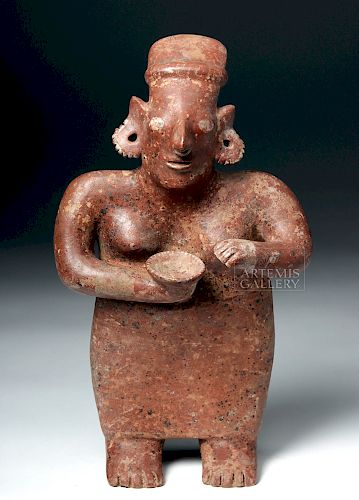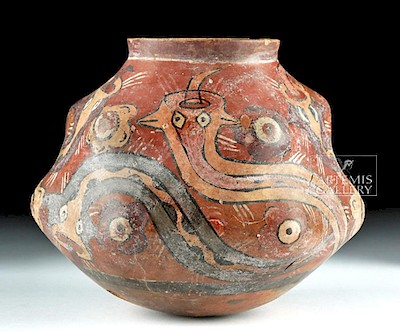Large Jalisco Sheepface Standing Female Figure
Lot 128
About Seller
Artemis Fine Arts
686 S Taylor Ave, Ste 106
Louisville, CO 80027
United States
Selling antiquities, ancient and ethnographic art online since 1993, Artemis Gallery specializes in Classical Antiquities (Egyptian, Greek, Roman, Near Eastern), Asian, Pre-Columbian, African / Tribal / Oceanographic art. Our extensive inventory includes pottery, stone, metal, wood, glass and textil...Read more
Estimate:
$8,000 - $12,000
Absentee vs Live bid
Two ways to bid:
- Leave a max absentee bid and the platform will bid on your behalf up to your maximum bid during the live auction.
- Bid live during the auction and your bids will be submitted real-time to the auctioneer.
Bid Increments
| Price | Bid Increment |
|---|---|
| $0 | $25 |
| $300 | $50 |
| $1,000 | $100 |
| $2,000 | $250 |
| $5,000 | $500 |
| $10,000 | $1,000 |
| $20,000 | $2,500 |
| $50,000 | $5,000 |
| $100,000 | $10,000 |
| $200,000 | $20,000 |
About Auction
By Artemis Fine Arts
Jul 5, 2018
Set Reminder
2018-07-05 10:00:00
2018-07-05 10:00:00
America/New_York
Bidsquare
Bidsquare : Ancient | Ethnographic | Fine Art
https://www.bidsquare.com/auctions/artemis-gallery/ancient-ethnographic-fine-art-3306
Featuring classical antiquities, ancient and ethnographic art from cultures encompassing the globe. Artemis Fine Arts info@artemisfinearts.com
Featuring classical antiquities, ancient and ethnographic art from cultures encompassing the globe. Artemis Fine Arts info@artemisfinearts.com
- Lot Description
Pre-Columbian, West Mexico, Jalisco, ca. 300 BCE to 300 CE. An enormous example of a shaft tomb figure, this is a standing sheepface female made from thick, red-slipped ceramic. She stands upon flat, naturalistic feet with stylized toes and easily poses on her own, with a broad skirt draped from her midsection down to her ankles. One bent arm holds a petite bowl while resting atop a slight distended abdomen, perhaps an indication of pregnancy, while the other hovers in front of globular breasts. A thick neck supports a large head detailed with a characteristic "sheepface" visage comprised of a thin mouth, pointed ears with perforated earspools, a prominent nose adorned with a simple nose ring, and coffee-bean-shaped eyes - all below an exaggerated forehead. Her necklace, earspools, skirt, and headband are all embellished with chalky-white painted details. With her significant stature and classic features, this is an exquisite example from ancient Western Mexico! Size: 8.75" W x 15.5" H (22.2 cm x 39.4 cm).
West Mexican shaft tomb figures like this one derive their names from the central architectural feature that we know of from this culture. These people would build generally rectangular vertical shafts down from the ground level down to narrow horizontal tunnels that led to one or more vaulted or rounded burial chambers. The geomorphology in the area means that these chambers are dug out of tepetate, a type of volcanic tuff material, which give the chambers a rough-edged look.
Although the dimensions of the chambers vary considerably - some only large enough to hold a single burial and its offerings, others seem designed to hold entire lineages - the placement of burial goods like this figure was very similar. Grouped with other figures, and alongside clay bowls, and boxes, they were positioned around the body (or bodies), near the skull. Unfortunately, we lack the information we would need to understand what these figures were made for - do they represent everyday people, even individuals? Are they religious? Were they created to mediate between the living and the dead? Whatever their purpose, today they are beautiful artwork and reminders of the mysterious past.
Provenance: private Pacific Palisades, California, USA collection; ex-private San Francisco, California, USA collection, acquired in 1970s
All items legal to buy/sell under U.S. Statute covering cultural patrimony Code 2600, CHAPTER 14, and are guaranteed to be as described or your money back.
A Certificate of Authenticity will accompany all winning bids.
We ship worldwide and handle all shipping in-house for your convenience.
#131039Expected surface wear commensurate with age, with small chips to toes, bowl, fingers, and ears. Minor chips and fading to pigmentation in several areas, otherwise intact and excellent. Great earthen deposits within recessed areas, and beautiful manganese deposits throughout.Condition
- Shipping Info
-
All shipping is handled in-house for your convenience. Your invoice from Artemis Gallery will include shipping calculation instructions. If in doubt, please inquire BEFORE bidding for estimated shipping costs for individual items.
-
- Buyer's Premium



 EUR
EUR CAD
CAD AUD
AUD GBP
GBP MXN
MXN HKD
HKD CNY
CNY MYR
MYR SEK
SEK SGD
SGD CHF
CHF THB
THB

















